When shopping for a handgun, you may wonder if you should get a hammer-fired or striker-fired pistol.
First, let’s talk about the similarities and differences. Both hammer-fired and striker-fired handguns are under spring tension but have different firing methods.
A hammer-fired handgun has an external “hammer” that is under spring tension at the back of the gun that strikes the firing pin. When it’s cocked, the hammer comes back. When the trigger is pulled and the hammer comes forward, it hits the firing pin causing an explosion with the gases forcing the bullet out of the barrel. There is an external hammer that you can visibly see (even if it’s recessed or flush).
When a striker-fired handgun is cocked, the striker (firing pin) is recessed and the horizontal spring is under tension. Once you pull the trigger, the spring is released and the striker goes forward hitting the primer of the cartridge causing an explosion with the gases forcing the bullet out of the barrel. You cannot visibly tell when the striker is under tension (some handguns have visual cues available).
There are Arguments for and Against Hammer-Fired Versus Striker-Fired Handguns.
Both can be used as concealed carry weapons. The reason you may not want a hammer-fired handgun is that something could block the hammer from striking the firing pin. You won’t have that issue with a striker-fired handgun. However, many striker-fired handguns may not work when in battery (pressed directly up against a target).
(Note: the Springfield Hellcat is an exception.)
Also Check Out: What’s the BEST Handgun?
Many hammer-striker handguns have both single- and double-action modes. This leads to less consistency with the travel of the trigger and subsequent reset once it’s fired. The first pull of the trigger is much longer until the hammer drops. Once the hammer drops, there is less trigger pull on the subsequent shots leading to an inconsistent trigger pull weight and length (this is why Dry Fire Training is critical). Striker-fired handguns remain the same for each pull of the trigger and each shot that is taken (and you should also utilize Dry Fire Training with striker-fired handguns).
Hammer-striker handguns may become snagged on your holster, clothing, or gear. Snags are less likely to occur with a striker-fired handgun (although it does happen depending on the sights or optics used). It’s a good idea to invest in a proper holster and practice drawing your handgun to avoid possible snags or issues.
Hammer-fired or Striker-Fired: What’s Best for You?
For most, it’s a personal choice. It may come down to grip and comfort, trigger pull length and weight, how you plan on using it, or the price. Both make a fantastic choice for target shooting, self-defense, or concealed carry. The best thing you can do is try them out at a local range to find what you prefer.
If you’re looking for a hammer-fired or striker-fired handgun, join Big Daddy Unlimited today!
Big Daddy Unlimited (BDU) is revolutionizing the online gun, gear, and ammo-buying process with the largest selection of in-stock products at everyday industry-leading prices! Our mission is to help our members exercise their Second Amendment right at prices they can live with while giving them the VIP service they deserve! Our passion for the 2A is unyielding, and we patriotically defend the freedoms upon which our great country was founded.
Our sales and services teams are the greatest benefit of our membership program and truly what sets us apart from other companies in the firearms industry. A quick call into BDU is the fastest way to solve a problem or grab that hard-to-find item! Give us a call at (800) 915-7709 to become a member today!
